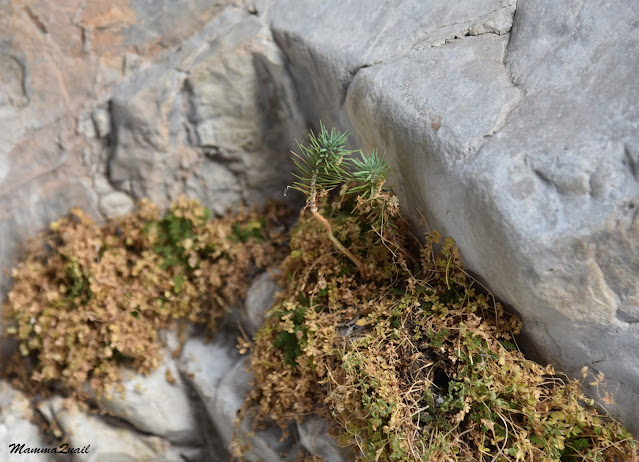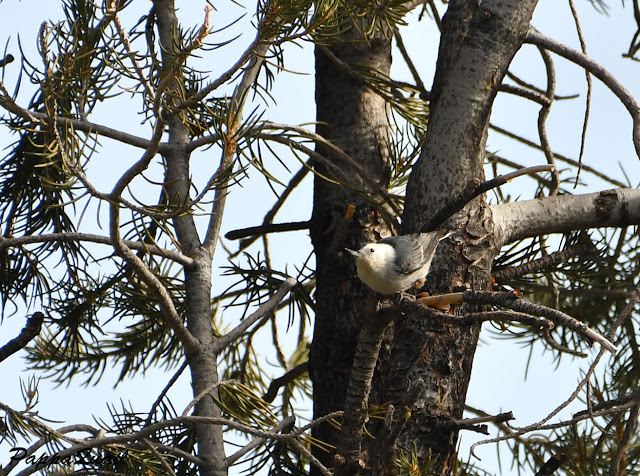Date: December 30, 2020
Place: Spring Mountains National Recreation Area, Las Vegas, Nevada
Coordinates: 36.263609, -115.611721
Length: 5 miles
Level: moderate
Our family 2020 winter trip to the Las Vegas area had a good balance of hike types - historical/cultural relics such as petroglyphs, spectacular geology, and of course, wildlife and birding walks. The day following our birding day we started by checking out a local stalactite cave, which was nice but not very memorable. At least, I don't remember much of it. After the cave visit we headed northwest into the Spring Mountains National Recreation Area to do what I insisted on calling 'a real hike'. I didn't have much of a plan however, so we selected a trailhead up the road. The choice was random however - up the mountain there was a lot of snow on the ground. I don't remember if the road was closed or if we simply didn't want to go too high into the snow area. Either way, we chose the Fletcher Canyon Trail, and after the first enthusiasm of seeing snow int he desert, we got ready for the hike.
The trail was an in-and-out one, and we didn't quite know where it would end so we thought we'd go up until we couldn't go any further, or until we'd had enough.
The beginning of the trail was covered in snow, which made me a bit wary. I was concerned about slipping and walked very carefully on the sleek path.
The day was beautiful however, and soon my concerns were dispelled by the brilliant sunshine and by the quiet, serene surrounding.
It was nice to walk through a forest, a real forest, for a change, after all the desert scenery. I love the desert, but I also love the mountains and their forests. Nearly all of the trees were conifers - pines, firs and cedars.
The trail was going uphill, but at a mild slope. A thin layer of snow covered most of the trail area, and we had to watch for icy patches along the way.
 |
| Fletcher Canyon Trail |
We didn't see a whole lot of bird activity, but there was some. Every now and then Pappa Quail and the elder chika would pause and try to pinpoint the location of the source of tweets. Sometimes they succeeded too.
Above the tree tops, wherever the forest opened up a bit, I could see the rocky cliffs of the mountain sides, too sheer to be covered by trees.
But the cliffs, sheer as they were, were not completely devoid of trees. Plants, even large trees, can germinate inside even the smallest rock crevice and slowly widen their root space in the rock as they grow to their full size. Trees hold together mountain soil but they are also a significant force in the erosion and the breaking down of the rock cliffs.
Many of the pine trees were laden with cones in various stages of maturation. The mature cones were still attached to their mother tree, fully open, allowing the pine nuts to fall down or be carried away by nut eating animals.
We were fortunate to see one of these nut eaters - a Cassin's finch. The pine nuts are a staple food fr many f these animals, especially during times when little else is available.
As we walked higher and higher up the trail the cliffs closed in on us, forming a canyon. During that time the clouds started moving in, stretching thin white wisps across the blue sky.
I looked up the cliff walls. Long, thick black streaks extended from the top or from cracks in the rock where water dripped throughout wet times for many years.
Below we had to take more care of where we were setting foot. The trail became sleeker and unstable rocks were hidden by the snow.
Trees were growing in the bottom of the canyon, reaching upward tall and thin, to reach the narrow strip of sunlight. We encountered several fallen logs on our way, and had to circumvent them carefully.
Here and there the canyon opened up a bit, allowing more sunlight to penetrated downward. Naturally, there were more trees growing in these wider sections of the canyon.
Not only trees were growing in the rock crevices. There were bushes and spreading shrubs. I was in awe as to the hardiness of these plants, and their ability to survive and even thrive in such tight places.
In a lower rock crevice I saw a baby pine tree, green and lush, stretching its baby needles to the light. Around it was another plant which I didn't identify. That plant looked less happy, but still very much alive.
 |
| Baby Pine |
Then the canyon narrowed even more and the vegetation dwindled to a few dry shrubs at the base of the sheer canyon walls. More and more large rocks that appeared to have fallen recently littered the bottom of the canyon and we begun wondering how further we should go.
 |
| Waterfall? |
We did stop for a brief snack break where there were rocks large enough to sit on after brushing off the snow cover. My family birders were a bit disappointed about the low count of birds that they saw. I looked at the snow covered plants nearby.
The high canyon walls kept us well shaded inside. We didn't sit for too long - it was getting colder in the shadow, and we needed to keep moving in order to stay warm.
Without much wildlife to look at I moved my attention to the geology - interesting layering patterns always fascinate me.
We made our way down the canyon at a pretty good pace. As we walked down more clouds gathered above and dimmed the sunlight. The mountain heights were still well lit.
We went down the sleek, snowy path, taking good care not to slip. Soon I was well behind the rest of my family, enjoying a few moments of quiet solitude.
I found an interesting pile of sticks that were placed next to a tree trunk forming a low shelter. It looked like a structure built by youth scouts or students in some survival class. I didn't think someone would actually spend the night here in a real survival situation so close to the road.
When I caught u with the rest of my family I found Pappa Quail and the elder chika staring up a tree through their cameras and binoculars.
I looked up there as well and saw what they were looking at - a sole downy woodpecker that was making its way up and down the branches looking for insects.
Behind us loomed one angular peak of the Spring Mountains. This was the south-facing slope and it was nearly devoid of snow.
Pine nuts were an important staple for the local overwintering animals. So were the manzanita berries. I found a few manzanita bushes that still had quite a lot of berries on them. I tasted a few- they were sweet but pretty dry in texture.
 |
| Manzanita, Arctostaphylos sp. |
Mountain mahogany seeds however, are not edible. Not for humans, anyway. They do look very pretty though. The feathery wing the mahogany seed has looked like a thin layer of frost.
 |
| Mountain Mahogany |
We covered quickly the short distance left to the trailhead. We didn't see any more birds or other wildlife, but we did run into one other hiker who came to walk his dog on this trail. He was the only other human that we saw on that entire hike.
I can see how this trail can be a wonderful summer relief for local hikers when the weather below is too hot to hike anywhere else. The snowy winter scene was a good change for us too, although wildlife activity was very low. We had a couple more hours of sunlight left for the day and decided to look for another trail in the area rather than go back early to town.





























The snow in this trail makes it very special. at leats in this area I guess
ReplyDeleteSnow in the desert is always special :-)
Delete